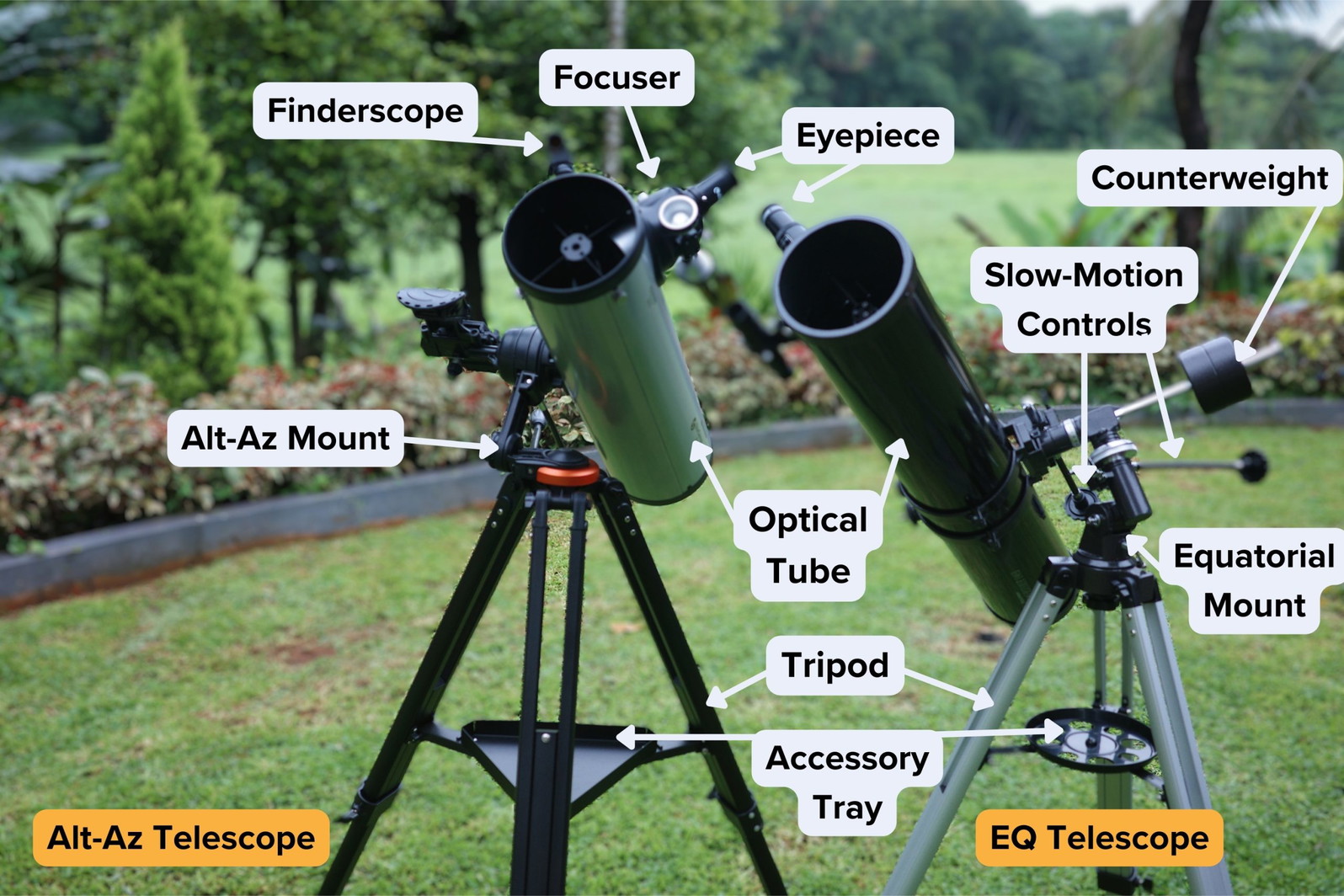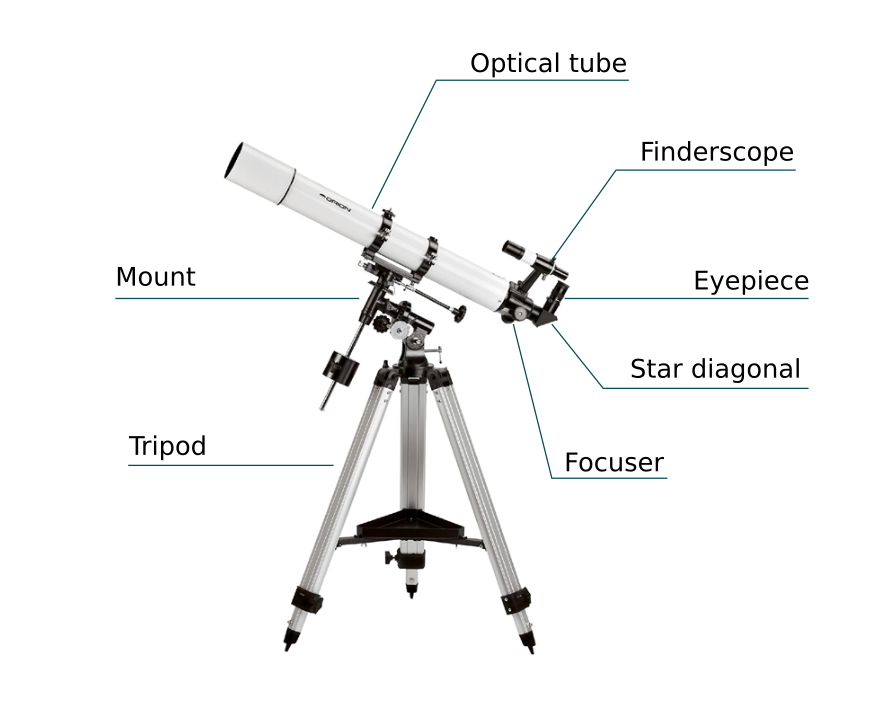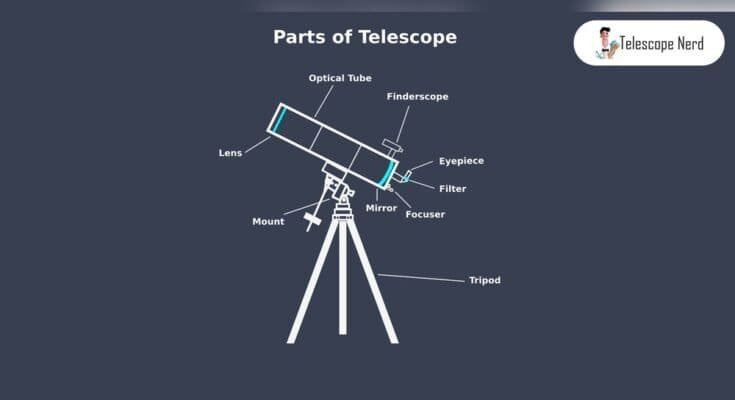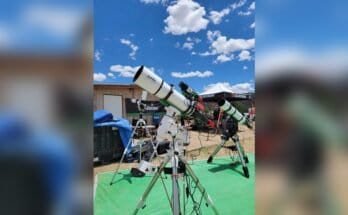Have you ever wondered how a refracting telescope brings distant stars and planets right into your view? Understanding the parts of a refracting telescope and how they work can change the way you see the night sky.
Whether you’re a beginner or just curious, knowing what each piece does will help you get the clearest, brightest images possible. Keep reading, and you’ll discover the simple secrets behind this amazing tool and how it can transform your stargazing experience.
Main Components
The main components of a refracting telescope work together to bring distant objects into clear view. Each part plays a key role in gathering and focusing light. Understanding these parts helps users appreciate how telescopes function.
Objective Lens
The objective lens is the largest lens at the front of the telescope. It collects light from distant objects and bends it to create an image. A bigger objective lens captures more light, making faint objects easier to see.
Eyepiece Lens
The eyepiece lens is where you look through the telescope. It magnifies the image produced by the objective lens. Different eyepieces offer varying levels of zoom and field of view.
Tube
The tube holds the objective lens and eyepiece in proper alignment. It blocks stray light that can blur the image. The tube also protects the internal lenses from dust and damage.
Focuser
The focuser moves the eyepiece closer or farther from the objective lens. This adjustment sharpens the image and brings details into clear view. Precise focusing is essential for a crisp picture.

Objective Lens Details
The objective lens is the most important part of a refracting telescope. It gathers light and focuses it to create a clear image. The quality and type of this lens affect how well you see distant objects. Understanding its details helps you choose the right telescope.
Lens Types
There are two main types of objective lenses. The first is the convex lens, which bends light inward to a focal point. The second type is the achromatic lens. It reduces color blur by combining two types of glass. This makes images sharper and clearer.
Lens Material
Objective lenses are made from different glass types. High-quality glass allows more light to pass through. Some lenses use special coatings to reduce reflections. These coatings improve image brightness and contrast. Plastic lenses are less common and offer lower image quality.
Aperture Size
The aperture is the diameter of the objective lens. Larger apertures collect more light, making faint objects visible. Bigger apertures also improve image sharpness and detail. Small apertures are easier to carry but show fewer details. Choose the aperture size based on your observing needs.
Eyepiece Functions
The eyepiece is a key part of a refracting telescope. It is where you place your eye to see the magnified image. The eyepiece changes how the image looks and how much you can see. It helps turn the focused light into a clear picture. Understanding its functions helps you get the best view of the night sky.
Magnification Role
The eyepiece controls the telescope’s magnification. It works with the main lens to enlarge distant objects. Different eyepieces offer different magnification levels. A higher magnification shows more detail but less of the sky at once. Lower magnification gives a wider view but less detail.
Lens Configurations
Eyepieces use various lens setups to improve the image. Some have simple lenses, while others have several lenses stacked together. These lens groups help reduce distortion and make images sharper. Quality lens configurations provide clearer and brighter views.
Field Of View
The field of view is how much sky you see through the eyepiece. A wider field shows more stars and space around the object. Narrow fields focus more on the object itself. Choosing the right field of view depends on what you want to observe.

Tube Structure
The tube structure is a key part of a refracting telescope. It holds the lenses in place and keeps them steady. This structure must be strong yet light. It also controls how light travels through the telescope. The tube helps to keep the image clear and sharp by reducing unwanted light and air movement.
Material Choices
Telescope tubes come in different materials. Metal is common because it is strong and durable. Aluminum is light and resists rust. Some tubes use plastic to save weight and cost. Wood is less common but offers good insulation. The material affects the tube’s stability and how well it protects the lenses.
Length And Diameter
The tube length depends on the telescope’s focal length. Longer tubes are needed for better magnification. The diameter of the tube matches the size of the objective lens. A wider tube lets in more light. This improves the brightness of the image. Both length and diameter affect the telescope’s power and clarity.
Light Shielding
Light shielding inside the tube reduces glare. The inner surface is often coated black or matte. This stops stray light from bouncing around. It helps keep the image dark and clear. Proper shielding improves contrast and makes details easier to see.
Focuser Mechanism
The focuser mechanism is an essential part of a refracting telescope. It helps to adjust the lens position to bring objects into clear view. Without a good focuser, images would appear blurry or out of focus. The mechanism allows smooth movement for precise adjustments.
Different focuser designs offer various features. Understanding these can help you choose the right telescope for your needs. The focuser also affects how easy it is to view objects at different distances.
Focusing Types
There are two main types of focusing systems: rack and pinion, and Crayford. Rack and pinion use gears to move the lens tube. Crayford focusers use smooth bearings for quieter operation. Each type has its own benefits for different users.
Adjustment Precision
Precision is key in a focuser. Fine adjustments help bring stars and planets into sharp view. Some focusers include dual-speed controls. These allow both quick and slow lens movements for better clarity.
Compatibility
Focusers must fit the telescope tube and eyepieces. Some models accept various eyepiece sizes and accessories. Compatibility ensures you can upgrade or change parts easily. Check the focuser size before buying add-ons.
Additional Parts
Refracting telescopes have more than just lenses and tubes. They include additional parts that help you aim, view, and stabilize the telescope. These parts make observing the sky easier and more comfortable. Understanding these extra components helps you get the best experience from your telescope.
Mount And Tripod
The mount holds the telescope steady. It allows smooth movement to follow objects in the sky. The tripod supports the mount and keeps the telescope stable. A good tripod prevents shaking and helps get clear images. Some mounts move manually, while others have motors for automatic tracking.
Diagonal Mirror
The diagonal mirror changes the direction of the light path. It makes viewing more comfortable by redirecting the image to the eyepiece at a better angle. This part helps you look through the telescope without bending your neck. It also corrects the image orientation for easier viewing.
Finderscope
The finderscope is a small telescope attached to the main one. It shows a wider view of the sky to help locate objects. Using the finderscope, you can aim the main telescope more precisely. It often has simple crosshairs or a red dot to guide your sight.
Common Issues
Refracting telescopes have several parts that work together to show clear images of distant objects. Sometimes, these parts face common issues that affect the quality of what you see. Understanding these problems helps you fix them quickly and enjoy better views.
Chromatic Aberration
Chromatic aberration happens when lenses do not focus all colors in the same spot. This creates color fringes around bright objects. It looks like a blurry rainbow edge. This issue is common in simple lenses. Using special lenses can reduce this problem.
Alignment Problems
Alignment issues occur when the lenses or parts are not set up correctly. Misaligned lenses cause blurry or distorted images. The telescope may not point exactly at the object. Regular checks and adjustments keep parts in line. This improves image clarity and focus.
Lens Cleaning Tips
Dirty lenses block light and reduce image quality. Clean lenses carefully using a soft brush or cloth. Avoid using harsh chemicals that can damage the glass. Always blow off dust before wiping. Clean lenses help produce sharp and bright images.

Frequently Asked Questions
What Are The Main Parts Of A Refracting Telescope?
A refracting telescope mainly has an objective lens, an eyepiece lens, a tube, and a focusing mechanism. The objective lens gathers light. The eyepiece magnifies the image. The tube holds these lenses in alignment. The focusing mechanism adjusts clarity for sharp viewing.
How Does The Objective Lens Function In A Refracting Telescope?
The objective lens collects and bends light to form a clear image. It is the largest lens at the front. This lens determines the telescope’s light-gathering power and resolution. A better objective lens means sharper and brighter images of distant objects.
Why Is The Eyepiece Important In Refracting Telescopes?
The eyepiece magnifies the image created by the objective lens. It allows the viewer to see distant objects in detail. Different eyepieces provide varying levels of magnification. This part also helps focus the image for clear observation.
How Does The Focusing Mechanism Improve Image Clarity?
The focusing mechanism adjusts the distance between the lenses. This change brings the image into sharp focus. It ensures that the viewed object appears clear and detailed. Proper focusing reduces eye strain and enhances the viewing experience.
Conclusion
Understanding refracting telescope parts helps you see the stars clearly. Each part has a special job to make images sharp. The lens bends light to focus distant objects. The tube holds everything steady. The eyepiece magnifies what you see. Knowing these parts makes using the telescope easier and more fun.
Now, you can explore space with confidence and curiosity. Simple tools, big discoveries.



